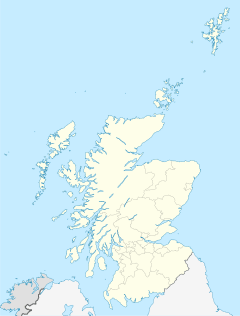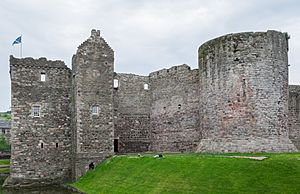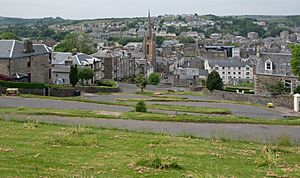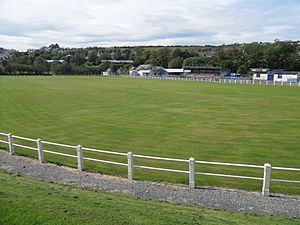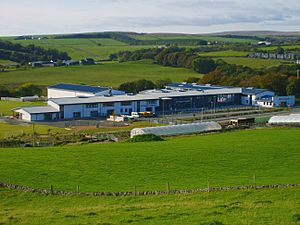Rothesay facts for kids
Quick facts for kids Rothesay
|
|
|---|---|
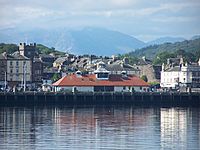 Rothesay Pier |
|
| Population | 4,310 (2020) |
| OS grid reference | NS 087 645 |
| • Edinburgh | 73 mi (117 km) |
| • London | 361 mi (581 km) |
| Council area |
|
| Lieutenancy area |
|
| Country | Scotland |
| Sovereign state | United Kingdom |
| Post town | ISLE OF BUTE |
| Postcode district | PA20 |
| Dialling code | 01700 |
| EU Parliament | Scotland |
| UK Parliament | |
| Scottish Parliament | |
Rothesay (pronounced ROTH-see) is the main town on the Isle of Bute in Scotland. It is part of the Argyll and Bute area. The town sits right on the coast of the Firth of Clyde.
You can get to Rothesay by ferry from Wemyss Bay. From there, you can take a train to Glasgow. In the middle of Rothesay, you'll find the ruins of Rothesay Castle. This castle was built in the 13th century and is special because it's the only castle in Scotland with a round shape.
Contents
What's in a Name?
In the Scottish Gaelic language, Rothesay is called Baile Bhòid. This means 'town of Bute'. The English name for the town has changed over time. In 1321, it was written as Rothersay.
Around 1400, it was called Rosay, and by 1500, it was Rothissaye. The name first referred to the castle. The castle was surrounded by a moat connected to the sea. So, the name might have meant 'Rother's Isle'. The old Norse word -ey means "isle". It could also come from the Gaelic word rath, which means 'fort'.
Rothesay's Past
The old town of Rothesay grew up around Rothesay Castle. This castle was built in the 13th century. Even though the castle is now a ruin, it looks very nice. It became a main attraction for tourists when Rothesay started to become a popular seaside resort.
Rothesay was once the main town of the old county of Bute. This county also included the islands of Great Cumbrae, Little Cumbrae, and Arran. The Rothesay Town Hall and County Buildings building stands near the castle.
Rothesay as a Tourist Hotspot
During the Victorian era, Rothesay became a very popular place for holidays. Many people from Glasgow came "doon the watter" (down the water). This meant they traveled down the Firth of Clyde by boat. The town's wooden pier was always busy with steamer boats.
Rothesay also had a "hydropathic establishment." These were like health spas popular at the time. There was even an electric tramway, the Rothesay and Ettrick Bay Light Railway. It went across the whole island of Bute. This tram took passengers to one of the island's biggest beaches. The tramway stopped running in the mid-1930s.
A special war memorial was put up in 1922. The Winter Gardens building, built in 1923, was a busy place in Rothesay. It hosted many famous music hall performers. The Rothesay Pavilion, opened in 1938, was another popular spot. It was built in a modern style. Although it later needed repairs, it is still a major landmark today. It is currently being fully restored.
Rothesay During World War II
During World War II, Rothesay Bay was an important port. It was home to HMS Cyclops. This ship was a base for the 7th Submarine Flotilla. It was also a training place for almost all British submariners during the war. From 1941 to 1942, a special training center for officers was also located here.
Changes in Modern Times
By the 1960s, Rothesay's time as a top tourist spot had mostly ended. People in the UK started taking cheaper package holidays abroad. The Winter Gardens building closed and was not used for many years. However, it was rebuilt in the 1990s. Now, it is a tourist information and exhibition center.
Rothesay received a big project to improve its harbor. This was ready for the new ferries, MV Argyle and MV Bute. In August 2018, the Donald Campbell Bluebird hydroplane was tested on Loch Fad. This was the first time the boat had been in water since it was found. It had been recovered from Coniston Water after an accident in 1967.
The Duke of Rothesay
The person who will become the next king or queen of Britain is known in Scotland as the Duke of Rothesay. This tradition started in the late 1300s. Robert III of Scotland, who was king, often stayed at Rothesay Castle. He first gave this title to his son, David, in 1398.
At that time, the name Rothesay meant the whole island of Bute. The town itself was called Bute-town. King Robert III controlled Bute and Arran islands. He inherited them from his family, the Stewarts. They had owned the islands since 1266. That's when King Alexander III of Scotland received them from Norway. He then gave them to Robert III's great-grandfather, Alexander Stewart.
The Stewart family privately owned these two islands. But when Robert II (Robert III's father) became king, the islands became property of the Crown. After Robert III gave this title to his son, every future heir to the Scottish throne also received it. When Scotland and England joined under one crown in 1603, the heir to the British throne also became the "heir to the Scottish throne." So, they got the title Duke of Rothesay.
Unlike the English title (Duke of Cornwall), the Duke of Rothesay title does not come with land. Instead, control of the land was given to Robert III's half-brother and his family. They later became known as the Marquess of Bute in the 1700s. The current marquess still owns most of the island's land. His main home, Mount Stuart, is a few miles south of Rothesay Castle.
Culture and Activities
Rothesay has hosted the Royal National Mòd twice. This is a big festival of Scottish Gaelic culture. It took place in Rothesay in 1908 and again in 1952.
Sports in Rothesay
The most successful sports team on the island is the Bute Shinty Club. Shinty is a traditional Scottish sport. The club has played at the highest level of the sport. They were promoted to the Premier League in 2006. They have also won the Balliemore Cup many times.
The town also has an amateur football club called Rothesay Brandane A.F.C. Their nickname is "The Danes." The club started in 1946. They played in the Scottish Amateur Football League from 1947. They reached the semi-final of the Scottish Amateur Cup in 1948–49. They won their league in 1963–64 and 2000–01. In 2004, they moved to another league. After winning promotion in 2007–08, they now play in Division 1. They also had a youth team for younger players.
The Bute County Cricket Club plays in a championship league. The island has three golf courses. The 18-hole Rothesay Golf Club is just outside town. The 9-hole Bute Golf Course is near Stravannan Bay. The 13-hole Port Bannatyne Golf Club is in the hills. There are also two putting greens on the seafront.
The town hosts a rugby camp every summer for the High School of Glasgow. For bowling fans, Bute has four greens. These are Ardbeg, Craigmore, Kingarth, and Rothesay. The Rothesay Bowling Club is the oldest, started in the 1860s. The Bute Bowling Association holds many local competitions. They also have an open tournament each August. Both ladies and gentlemen can compete in it.
Education in Rothesay
Rothesay has three primary schools: St Andrews Primary School, Rothesay Primary School, and North Bute Primary School. It has one secondary school, Rothesay Academy. In 2007, Rothesay Primary and Rothesay Academy joined together. They now share a new building. The old Rothesay Academy building was closed.
Famous People from Rothesay
- Prof Eleanor Campbell: a scientist who studies physical chemistry.
- Nathanael Chalmers: an explorer.
- Johnny Dumfries: a former Formula One racing driver.
- Andrew Blain Baird: a pioneer in aviation.
- Thomas Gillies: a New Zealand lawyer, judge, and politician.
- Angela Haggerty: a journalist and social commentator.
- George Leslie: a famous painter.
- Ian Jenkins: a politician.
- Ashley Lilley: an actor, known for playing Ali in Mamma Mia.
- Sir William Macewen: a pioneer in brain surgery.
- Sheina Marshall: a zoologist.
- Troy Kennedy Martin: a writer, known for Z-Cars.
- Jim McAlister: a footballer.
- John McIndoe: a printer.
- Billy McIsaac: a keyboard player for several bands.
- Peter Monie: a civil servant.
- Jane Ross: a Scottish international footballer. She was a reserve for Team GB at the London 2012 Olympic Games.
- Prof Martin Smellie (1927-1988): a biochemist.
- John Tiffin Stewart: a civil engineer.
- Matthew Stewart: a mathematician.
- John Stuart, 3rd Earl of Bute: the first Scottish Prime Minister of Great Britain. He is buried in St Mary's Chapel, Rothesay.
- John McLean Thompson: a botanist.
- Sir Graham Watson: a politician from the Liberal Democrat party. He was a member of the European Parliament.
- Lena Zavaroni: a singer and child star.
Rothesay's Climate
Like the rest of Scotland, Rothesay has a maritime climate. This means it has cool summers and mild winters. Because it's on an island, the water around it helps to reduce the risk of very cold weather. Temperatures can reach as high as 28.5 °C (83.3 °F) (in August 1975). They can also drop as low as −8.4 °C (16.9 °F) (in January 1982).
| Climate data for Rothesay (43 m or 141 ft asl, averages 1991–2020, extremes 1960–present) | |||||||||||||
|---|---|---|---|---|---|---|---|---|---|---|---|---|---|
| Month | Jan | Feb | Mar | Apr | May | Jun | Jul | Aug | Sep | Oct | Nov | Dec | Year |
| Record high °C (°F) | 14.0 (57.2) |
14.6 (58.3) |
16.6 (61.9) |
22.6 (72.7) |
25.5 (77.9) |
28.1 (82.6) |
28.0 (82.4) |
28.5 (83.3) |
25.0 (77.0) |
21.0 (69.8) |
16.8 (62.2) |
14.4 (57.9) |
28.5 (83.3) |
| Mean daily maximum °C (°F) | 7.5 (45.5) |
7.8 (46.0) |
9.4 (48.9) |
12.0 (53.6) |
15.0 (59.0) |
17.2 (63.0) |
18.7 (65.7) |
18.4 (65.1) |
16.3 (61.3) |
12.9 (55.2) |
9.8 (49.6) |
7.8 (46.0) |
12.7 (54.9) |
| Mean daily minimum °C (°F) | 2.7 (36.9) |
2.6 (36.7) |
3.3 (37.9) |
4.8 (40.6) |
7.1 (44.8) |
9.7 (49.5) |
11.5 (52.7) |
11.5 (52.7) |
9.9 (49.8) |
7.2 (45.0) |
4.9 (40.8) |
3.0 (37.4) |
6.5 (43.7) |
| Record low °C (°F) | −8.4 (16.9) |
−5.6 (21.9) |
−4.5 (23.9) |
−4.4 (24.1) |
−1.6 (29.1) |
2.0 (35.6) |
3.9 (39.0) |
4.4 (39.9) |
1.0 (33.8) |
−1.9 (28.6) |
−2.5 (27.5) |
−5 (23) |
−8.4 (16.9) |
| Average rainfall mm (inches) | 165.7 (6.52) |
127.2 (5.01) |
118.9 (4.68) |
86.5 (3.41) |
78.6 (3.09) |
90.2 (3.55) |
107.5 (4.23) |
124.0 (4.88) |
117.3 (4.62) |
163.3 (6.43) |
159.1 (6.26) |
160.3 (6.31) |
1,498.6 (58.99) |
| Average rainy days (≥ 1 mm) | 19.7 | 16.9 | 16.2 | 13.5 | 12.5 | 13.4 | 14.7 | 15.3 | 15.5 | 18.3 | 19.4 | 18.8 | 194.2 |
| Mean monthly sunshine hours | 41.0 | 67.7 | 101.8 | 151.5 | 200.9 | 172.2 | 156.2 | 154.8 | 116.1 | 81.0 | 53.7 | 35.8 | 1,332.7 |
| Source 1: Met Office | |||||||||||||
| Source 2: Royal Dutch Meteorological Institute/KNMI | |||||||||||||
Images for kids


